|
DRS ARMOR X10 Tablet
9th generation ultra-rugged tablet computer
(by Conrad H. Blickenstorfer)
Once upon a time there was the WalkAbout Hammerhead, a super-rugged pen computer going back to the early 1990s. The concept — essentially a tablet milled from a solid block of metal — was so good that it really didn't need change at all, except for updating electronics every once in a while. Eventually, WalkAbout became part of DRS Technologies and is now known as DRS Tactical. With parent DRS being a major supplier of integrated products, services and support to military forces, intelligence agencies and prime contractors worldwide, this opened up a lot of new opportunities.
In February of 2008, DRS Tactical announced ARMOR, a line of rugged mobile computers with an emphasis on data protection technology, anywhere connectivity and sunlight readable display options for industrial and government customers. The initial products of the ARMOR line include the X10 Tablet PC shown here and the C12 convertible notebook. DRS was nice enough to send us a X10 review unit for extended testing.
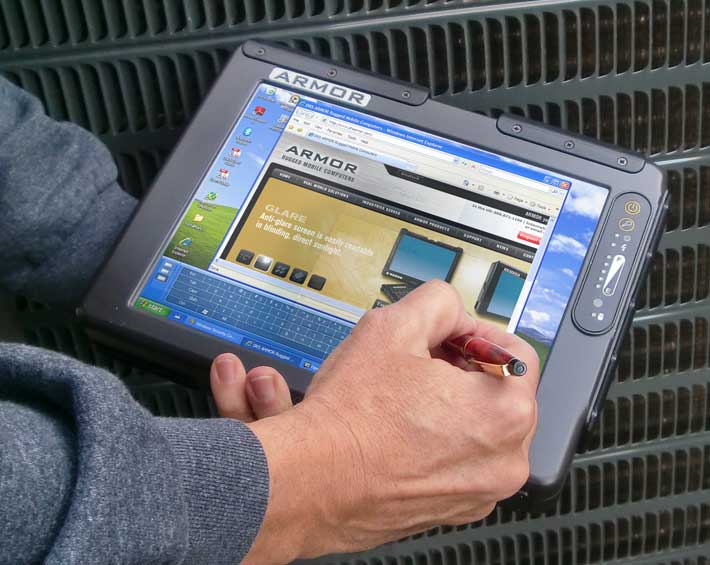
9th generation design
Those familiar with rugged computing technology will easily recognize the ARMOR X10's as the latest in a long evolutionary chain of Hammerhead tablets. In fact, by our count, the X10 is a member of the 9th generation of what began in the early 1990s as a revolutionary, no-nonsense design concept for an ultra-rugged and nearly invulnerable mobile tablet computer. In 1996, we reviewed the Hammerhead 586, an upgrade to the original Hammerhead that was first delivered to customers in June of 1995 with a 486 processor. The 586 model, which could run MS-DOS 6.22 and Windows for Pen Computing, used a Cyrix 5x86/100 processor for significantly increased performance, added support for a Rockwell GPS receiver, and even had an internal thinfilm heater option for extended low temperature operation. The design, ergonomics, and overall functionality of that early Hammerhead was so good that it hardly needed change in the 12 years since then, but technology marches on and so each successive generation freshened the Hammerhead's electronics and technology to current standards.
To get an idea of how the platform developed, see our review of the 1995 Hammerhead 586 and the comprehensive review we did on the Hammerhead Xtreme ten years later. In the latter we found the machine as competent and purposeful as ever, but under the hood (or rather inside its case milled from aircraft-grade aluminum) it was no longer quite up to date. The X10 takes care of that with a processor upgrade to the ultra-low voltage 1.2GHz Intel Core Duo U2500. Maximum RAM has gone up to 2GB, available hard disks are up to 80GB, and a 8 or 16GB solid state disk is an option, and there are related and ancillary electronic enhancements.
Building on a solid foundation
The ARMOR X10 has a compact footprint identical to that of a U.S. standard sheet of paper -- 8.5 x 11 inches -- and it is exactly 1.5 inches thick. Like Hammerheads before it, the basic housing indeed starts life as a solid block of 6061-T6 aluminum, where 6061 defines the type of aluminum and T6 the heat-treating process. It's an exceedingly solid unit that feels utterly invulnerable. The spec sheet lists a weight of 5.2 pounds. Our unit weighed 5.7 pounds, but that was with two batteries installed. We weighed it that way because most customers will use the X10 with both batteries. The original Hammerhead, by comparison, weighed barely more than four pounds, so the latest model feels pretty substantial and DRS should keep weight in mind.
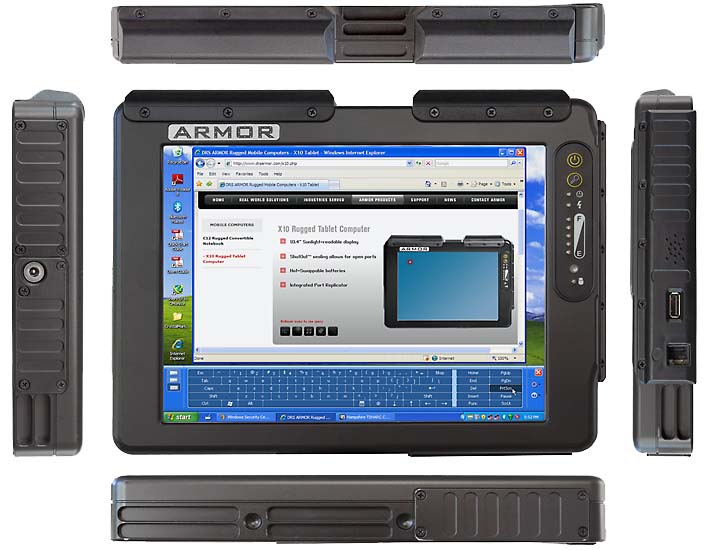
In terms of overall design, the X10 is still a rectangular block, but it's no longer quite as bare and extreme as the earliest generations. Edges and corners are neatly rounded, all four side have doors and covers screwed on, and there is a good deal of ornamental contouring on the elegantly finished matte-black aluminum body.
The ARMOR X10 breaks with time-honored Hammerhead tradition in that it offers an externally accessible USB port. Earlier models really did look as if they were milled from a solid block of metal with virtually all connectivity through an external dock whereas the latest platform makes several concessions to easy access. This probably makes sense as readily available USB ports have become almost mandatory, but we did notice that, despite trademarked "ShutOut" technology, IP67 sealing, which was optionally available on the 8th generation Hammerhead Xtreme, is no longer listed. IP66 means the unit is impervious to dust and water spray from all directions, but it's no longer certified to survive immersion in water.
The screwed-on protective covers and caps have increased overall exterior dimensions by just a bit, but our main concern would be the sealing properties of many screw-on covers. Anytime things are held in place by over 30 screws, something could go wrong.
Looking at the unit's front and all four sides, the bottom provides access to the hard disk (a Fujitsu 80GB 5400rpm disk with a Serial ATA-150 interface in our machine); on the left one cover seems for future expansion and had nothing beneath it on our tester, whereas the second one protected and sealed the PC Card compartment with its two Type II sockets. The top features two plastic caps that cover externally mounted SkyCross CBL-EMWQU-A 2.4-2.5 and 4.9-5.9 GHz antennas. The right has the aforementioned USB 2.0 port as well as a RJ-45 LAN jack and a speaker.
The front of the computer is dominated by a 10.4-inch XGA display that is available either with a touch screen and an electromagnetic digitizer. Our unit had the touch screen. To the right of the display is a panel that includes the on/off switch, a security switch, a light sensor, and indicator lights for hard disk activity and battery charge.
Two Type II PC Card slots (or one Type II card) can be used for expansion and the X10 also offers a "FlexSpace" OEM socket that can accommodate a variety of options. The X10 comes with integrated 802.11a/b/g WiFi and Bluetooth. The X10 is also backward compatible with any Hammerhead port replicator and desk, vehicle and wall dock ever made.
Benchmark performance
Makers of mobile systems usually select a workhorse CPU that combines performance and economy. The chip must be powerful enough to handle the workload now and two or three years into the future. It also must be miserly enough to allow acceptable battery life in the field and on the job. The designers of several current vertical market and industrial systems found such a chip in the 1.2GHz Intel Core Duo U2500 processor. This is an ultra-low voltage chip that's been around since early 2006 and turned out to be a reliable performer with many of the features that made Intel's dual core processors so popular and successful. Its thermal design power (TDP) of about ten watts is only a fraction of that of a desktop or even most laptop computers, yet performance is amazingly good.
We ran Passmark Software's PerformanceTest 6.1 that runs about 30 tests covering CPU, 2D graphics, 3D graphics, memory, and disk and then computes scores for each category and an overall PassMark score. For comparison, we're listing another DRS machine, the ARMOR C12 that uses a Core Solo U1400 processor, as well as the Xplore Technologies iX104C4, a machine that competes directly with ARMOR X10.
|
PERFORMANCE COMPARISON
|
DRS ARMOR X10
|
DRS ARMOR C12
|
Xplore iX104C4
|
|
Processor
|
1.2GHz Intel Core Duo U2500
|
1.2GHz Intel Core Solo U1400
|
1.2GHz Intel Core Duo U2500
|
|
Thermal Design Power (TDP)
|
10.0 watts
|
5.5 watts
|
10.0 watts
|
|
CPU Mark
|
604.4
|
329.4
|
612.1
|
|
2D Graphics Mark
|
161.1
|
174.7
|
152.6
|
|
Memory Mark
|
243.4
|
251.4
|
245.7
|
|
Disk Mark
|
232.7
|
247.9
|
326.5
|
|
3D Graphics Mark
|
99.4
|
87.0
|
98.1
|
|
Overall PassMark
|
288.0
|
218.7
|
307.9
|
The results show the significant advantage of the dual core processor that greatly outperforms the single core processor even at a lower clock speed.
This is a very good result and roughly on par with some of the fastest pure tablets on the market. Making a Solid State Disk available as an option is a wise move. The mean time between failure of SSD drives is six times longer than for conventional hard disks, boot and data access are significantly faster, and battery life of SSD-equipped machines can be as much as 10% longer. At this point, ARMOR offers an 8 or16GB SSD; larger one should become available.
Display and digitizer
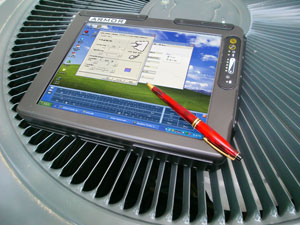 The DRS ARMOR X10 comes with a 10.4-inch display that offers 1024x768 XGA or resolution. The display can be ordered with a traditional CCFL (cold cathode fluorescent lamp) backlight, or a LED (light-emitting diode) backlight, a type of backlight that has been making inroads in notebook computers. The LCD itself is a transmissive design that DRS describes as "sunlight readable."
The DRS ARMOR X10 comes with a 10.4-inch display that offers 1024x768 XGA or resolution. The display can be ordered with a traditional CCFL (cold cathode fluorescent lamp) backlight, or a LED (light-emitting diode) backlight, a type of backlight that has been making inroads in notebook computers. The LCD itself is a transmissive design that DRS describes as "sunlight readable."
Earlier generations of the machine were available with a variety of display technologies for different working environments. For indoors, customers could consider either an SVGA (800 x 600 pixels) or an XGA (1024 x 768 pixels) transmissive LCD for its brightness. For outdoor use there was a reflective XGA screen that worked best in direct sunlight, and also a transflective "All-Vis" SVGA display as a compromise for indoor and outdoor use.
A Hammerhead Xtreme review unit we tested in 2005 had the front-lit XGA reflective screen. Anyone remembering the earliest Compaq iPAQ Pocket PC knows how that type of screen worked. It provided good contrast in direct sunlight and acceptable readability indoors. However, screen illumination came from the front via a light tube mounted along the top bezel of the screen, making for glare and uneven illumination of the display. For several years, transflective displays that merged transmissive and reflective technologies were used as a compromise. For the past two or three years, the momentum has swung to transmissive LCDs with special optical coatings (anti-reflective materials and circular polarizers) that cut ambient light reflected by the screen way back.
This appears to be the approach DRS has taken with the ARMOR X10's display. Realize that a touch screen makes providing good sunlight viewability even more difficult as there are several additional layers sitting on top of the LCD, and each layer can reflect light if not properly treated/coated.
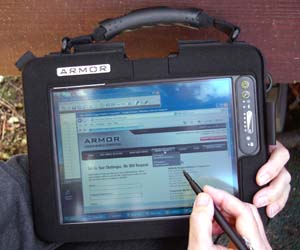 When you first take the ARMOR X10 outside and into bright sunlight, the screen doesn't appear to be very bright and clear, and there is a bluish cast to the display. DRS applied significant anti-glare treatment to the display, almost eliminating the annoying "mirror" effect of the glossy displays most consumer notebooks have today. However, while anti-glare treatment cuts down on glare, it can also make the display look duller and more difficult to read. When you first take the ARMOR X10 outside and into bright sunlight, the screen doesn't appear to be very bright and clear, and there is a bluish cast to the display. DRS applied significant anti-glare treatment to the display, almost eliminating the annoying "mirror" effect of the glossy displays most consumer notebooks have today. However, while anti-glare treatment cuts down on glare, it can also make the display look duller and more difficult to read.
One big thing the DRS display has going for itself is that its surface is completely flat, something that does not apply to all displays we see in rugged equipment. A flat surface does not confuse the eye with warped reflections. That seems like a little thing, but it is not.
The picture on the left shows the ARMOR X10 outdoors on a sunny day, but not in direct sunlight. As you can see, the screen is clearly visible and readable. The anti-glare treatment removes mirror-like reflections, but some reflection can still be seen. For best impact, anti-glare treatment must work in tandem with effective anti-reflective treatment, else the reflections are simply diffused, cutting down readability.
Another quality of a LCD display is its horizontal and vertical viewing angle. We've become spoiled by the incredible BOE Hydis display with its near-180 degree viewing angle in all directions, and viewing angle has thus becoming a judging criterion for LCDs. The X10's LCD has an acceptably wide vertical viewing angle, though there is some color shift as you vary angle. The horizontal viewing angle is very wide, almost 180 degrees, but the display gets milky when viewed from extreme horizontal angles.
Overall, one must realize that there are no perfect sunlight-viewable displays today. All current technology can do via optical treatments and strong backlights is provide enough effective, or "real world," contrast ratio to make the display usable outdoors. The X10 display does that. You need to work with it, though, and try to find an angle that works for you and avoids glare and reflections.
Could DRS have done better with their display? Some, but not much. The optical display treatment works well. If anything, I'd consider including an ultrabright backlight that can be turned on and off via hardware button so as not to be a drain on the battery when it is not needed. We've seen this solution on the rugged Getac B300 notebook and consider it very effective.
Armor Utilities
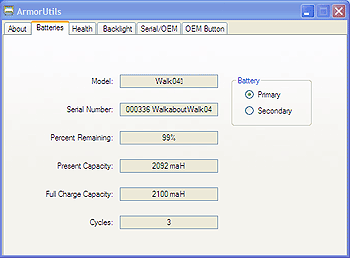 DRS gave the ARMOR X10 a handy, informative utility panel. Tablet PCs rely on such information summary and configuration setting applications more than commercial notebook computers. The ArmorUtils include: DRS gave the ARMOR X10 a handy, informative utility panel. Tablet PCs rely on such information summary and configuration setting applications more than commercial notebook computers. The ArmorUtils include:
- About shows BIOS, EC, LED and other version info as well as the serial number.
- Batteries shows full charge capacity, present capacity, percent remaining, cycles, and serial number for both of the X10's batteries.
- Health shows temperatures of the CPU core, the system, as well as of the primary and secondary battery.
- Backlight is where you determine whether backlight intensity is controlled manually or via light sensor. You can set the brightness level, and there is also a separate Advanced Backlight Control where you can construct a custom backlight template with minimum brightness and start and end ramp settings.
- Serial/OEM is where you toggle the GPS, three OEM lines, and Port B routing on and off.
- OEM Button lets you set the side hardware button to backlight cycling, sleep, or Windows defined.
While it certainly serves a purpose, ArmorUtils panel isn't optimized for touch and we'd like to see more tablet-oriented functionality and an onboard or integrated help facility.
Power
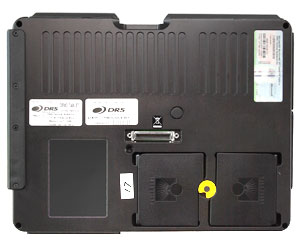 One thing that has always set Hammerheads apart is their innovative battery arrangement consisting of two externally mounted Li-Ion batteries rated at 24.4 watt-hours each (up from 20 watt-hours each in the prior generation). The two batteries are securely held in place by an ingenious thumb wheel that you need to turn just right to remove a battery (see image on the right). One thing that has always set Hammerheads apart is their innovative battery arrangement consisting of two externally mounted Li-Ion batteries rated at 24.4 watt-hours each (up from 20 watt-hours each in the prior generation). The two batteries are securely held in place by an ingenious thumb wheel that you need to turn just right to remove a battery (see image on the right).
The Hammerhead will operate fine with just one battery, and so you can keep replacing batteries without ever needing to shut the unit down. You cannot, however, remove both at the same time without an external power source. This would require an internal backup/bridge battery, which the X10 does not have.
While X10 specs list weight with just one battery installed, we do not recommend a single battery configuration if you plan on running the unit for any length of time. 24 watt-hours just isn't enough, and even the 50 watt-hours provided by both batteries is somewhat marginal for a machine this powerful. This remains one of the few areas where we'd like to see DRS make a significant change.
Wireless
The ARMOR X10 comes with integrated 802.11a/b/g WiFi. Additional wireless functionality can be added via what DRS calls a "FlexSpace" OEM socket. If needed, the X10 can be ordered with an integrated SiRF III GPS receiver. Bluetooth version 2.0 is available. There are also the two internal Type II PC Card slots mentioned above (or you can use the slot for one Type II cards).
Security
Security is becoming an ever more important part of a mobile computer's specifications. In this area, the ARMOR X10 offers hard disk password protection, a data deletion tool, device protection that permits locking the USB port, I/O lock, encrypted virtual drive technology, and the usual password hierarchy.
The ARMOR X10 also has a trusted platform module (TPM) security chip that can be used to create and manage computer-generated digital certificates. Combined with software, these certificates can be used to:
- Send and received secure email,
- Set up the browser for client identification,
- Sign Word macros,
- Encrypt individual files or entire folders, and
- Create secure network connections.
All of this can get pretty involved. Some users may never implement TPM or even password hierarchies, whereas others may configure their X10 in accordance with advanced IT security procedures.
Ruggedness
The original WalkAbout Hammerhead was conceived from the ground up as an ultra-rugged device by some of the very pioneers in the rugged pen computing slate industry. At a time when a lot of ruggedized computers still looked more like science projects, the WalkAbout folks literally milled a computer from a solid block of metal. It was a deceptively simple, fan-less design that combined all connectivity into a single point of contact in the center of the backside of the unit. A smartly conceived port replicator connected to it, and doubled up as a desk stand. The central connector in the back is still there, and docks and port replicators from all previous generations of Hammerheads are compatible with the new ARMOR X10. As tough as the original Hammerhead was, its designers also sold what was then by far the best custom-designed and form-fitting case available.
 Environmental specs are impressive. The X10 can operate within an extremely wide temperature range of between -4 to 140 degrees Fahrenheit. It can survive the 26 drops on each face, side and corner mandated in MIL-STD-810F 516.5, Procedure IV. Sealing against the elements is generally measured by an Ingress Protection rating. The X10 scores an IP66, which means it is totally protected against dust, and also against water from all sides. However, the machine is no longer certified to survive immersion in water as was its IP67-rated predecessor. The ability to handle vibration was tested in accordance with procedures mandated in MIL-STD-810F 514.5, and DRS also addressed all pertaining EMI/EMC and safety issues. Environmental specs are impressive. The X10 can operate within an extremely wide temperature range of between -4 to 140 degrees Fahrenheit. It can survive the 26 drops on each face, side and corner mandated in MIL-STD-810F 516.5, Procedure IV. Sealing against the elements is generally measured by an Ingress Protection rating. The X10 scores an IP66, which means it is totally protected against dust, and also against water from all sides. However, the machine is no longer certified to survive immersion in water as was its IP67-rated predecessor. The ability to handle vibration was tested in accordance with procedures mandated in MIL-STD-810F 514.5, and DRS also addressed all pertaining EMI/EMC and safety issues.
From personal experience, we'd recommend the above-described carry case whose shock-absorbing materials add even more ruggedness and which also prevents scratching that is almost inevitable with metal housings. The case has changed a bit to provide access to ports and doors. Velcro is used now instead of the zipper, and the dense foam roll handle has been replaced by sturdy rubberized plastic (see above).
DRS stresses its trademarked "ShutOut sealing technology that allows for open ports. Given the unit's IP66 ingress protection rating, this must work well. We noticed that all protective covers use the same design approach: a ridged hard plastic or metal cover presses down on a sticky, dense neoprene gasket to create a seal that functions like an O-ring.
Peripherals
Desk and vehicle docks and port replicators are very important to mobile computers, and especially so for slates and tablets that do not have integrated keyboards and may not have a lot of externally accessible connectivity. I already mentioned the X10's expansion connector that's centrally located in the unit's backside. The advantage of dealing with a company that's been in the rugged business for as many years as DRS is that docking peripherals do not become obsolete. In fact, peripherals from all nine product generations work with the new ARMOR X10. That's quite remarkable and a very economical and customer-friendly way of doing business.
Summary
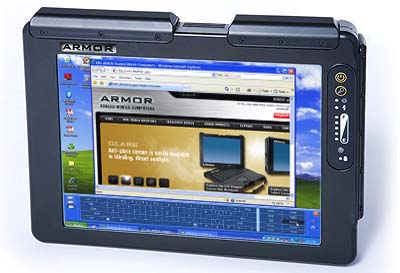 The DRS ARMOR X10 is part of a line of industrial computers offered by DRS Tactical Systems, a unit of DRS Technologies, which is a large and experienced supplier of integrated defense electronics products, services and support.
The DRS ARMOR X10 is part of a line of industrial computers offered by DRS Tactical Systems, a unit of DRS Technologies, which is a large and experienced supplier of integrated defense electronics products, services and support.
The X10 is a compact, uncompromising ultra-rugged tablet computer for use in the harshest environments. The basic design of this machine was conceived by pioneers in the rugged computing industry in the early 1990s, and has been refined and improved over the past 15 years in no fewer than nine product generations. The result is a field-proven design with no weaknesses.
This latest model has updated electronics that put its performance on par with the competition. It also has more externally accessible connectivity than before while retaining its internal expansion and configuration flexibility. The machine has an outdoor and sunlight-viewable 10.4-inch display and is available with either a touch screen panel or an electromagnetic digitizer.
Technologically up-to-date, this latest generation Hammerhead remains an excellent tool for rugged computing jobs in fields such as utilities, public safety, construction, manufacturing, military, and other applications that require computing power in a nearly indestructible package.
– Conrad H. Blickenstorfer
|
DRS ARMOR X10 Specifications
|
| Added/changed |
Added 03/2008; updated with full review 11/2008
|
| Type |
Rugged Tablet PC slate
|
| Processor |
1.2GHz Intel Core Duo U2500 |
| OS |
Windows XP Tablet PC |
| Memory |
512MB/2048MB SDRAM DDR2 |
| Chipset |
unknown |
| Display |
Outdor-readable 10.4-inch/1024x768 pixel transmissive TFT with CCFL or LED backlight |
| Digitizer/Pens |
Either electromagnetic (Wacom) or touch panel, strengthened and coated glass |
| Keyboard |
external option |
| Storage |
5400 rpm SATA-150 80GB Fujitsu MHY2080BH, or 8/16GB solid state disk |
| Slots |
2 PC Card Type II (or 1 Type III), OEM "FlexSpace" socket |
| Housing |
DuraCase aluminum housing |
| Temperature |
-4 to 140 degree F |
| Enclosure Class |
IP66 |
| Humidity |
5-95% without condensation |
| Drop |
26 x 4-foot to plywood |
| Vibration |
514.5, procedure I, category 4
|
| Altitude |
8,000 feet operating |
| EMI/EMC |
FCC Part 15 Class B, CISPAR 22 B, immunity measurement: IEC 61000-4-2 |
| Size |
11.1" x 8.5" x 1.5" |
| Weight |
5.75 lbs. (our test unit, including battery) |
| Power |
Dual 11.1V/2,200mAh 24.4 watt-hour Li-Ion ("4-6 hours actual usage" |
| Communication |
USB, LAN |
| Interface |
Integrated 802.11a/b/g, Bluetooth 2.0 or SiRF III GPS |
Price |
inquire |
| Contact |
DRS ARMOR or call 321-727-3672 |
|
|



